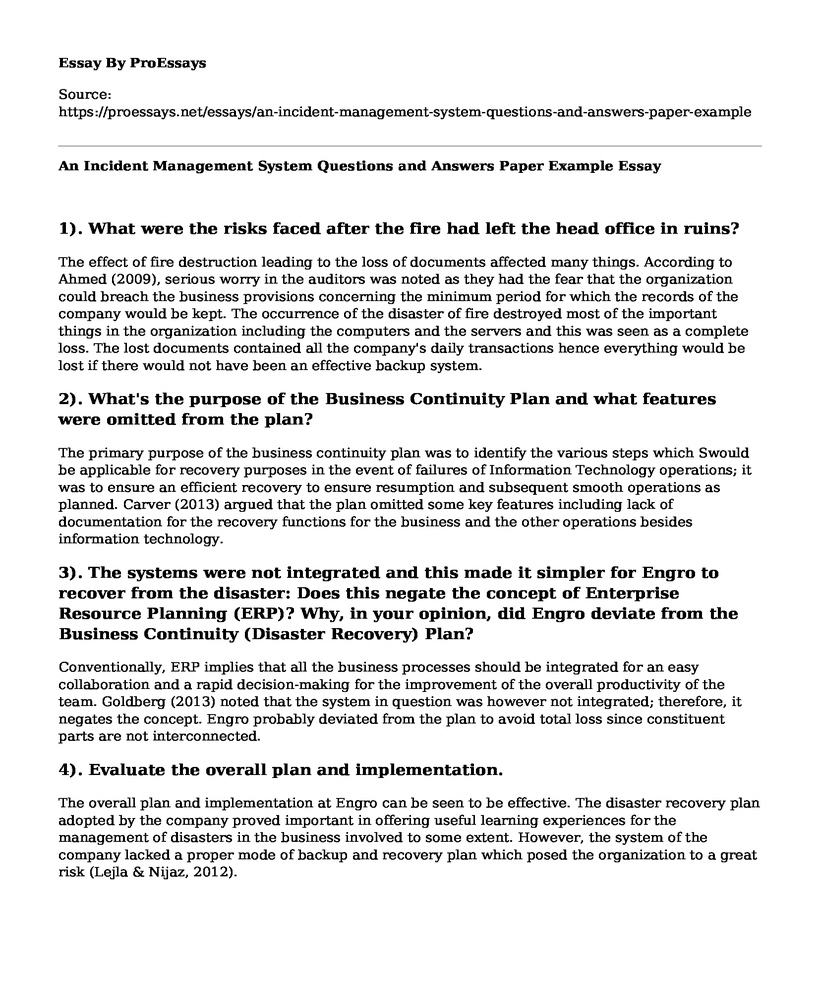1). What were the risks faced after the fire had left the head office in ruins?
The effect of fire destruction leading to the loss of documents affected many things. According to Ahmed (2009), serious worry in the auditors was noted as they had the fear that the organization could breach the business provisions concerning the minimum period for which the records of the company would be kept. The occurrence of the disaster of fire destroyed most of the important things in the organization including the computers and the servers and this was seen as a complete loss. The lost documents contained all the company's daily transactions hence everything would be lost if there would not have been an effective backup system.
2). What's the purpose of the Business Continuity Plan and what features were omitted from the plan?
The primary purpose of the business continuity plan was to identify the various steps which Swould be applicable for recovery purposes in the event of failures of Information Technology operations; it was to ensure an efficient recovery to ensure resumption and subsequent smooth operations as planned. Carver (2013) argued that the plan omitted some key features including lack of documentation for the recovery functions for the business and the other operations besides information technology.
3). The systems were not integrated and this made it simpler for Engro to recover from the disaster: Does this negate the concept of Enterprise Resource Planning (ERP)? Why, in your opinion, did Engro deviate from the Business Continuity (Disaster Recovery) Plan?
Conventionally, ERP implies that all the business processes should be integrated for an easy collaboration and a rapid decision-making for the improvement of the overall productivity of the team. Goldberg (2013) noted that the system in question was however not integrated; therefore, it negates the concept. Engro probably deviated from the plan to avoid total loss since constituent parts are not interconnected.
4). Evaluate the overall plan and implementation.
The overall plan and implementation at Engro can be seen to be effective. The disaster recovery plan adopted by the company proved important in offering useful learning experiences for the management of disasters in the business involved to some extent. However, the system of the company lacked a proper mode of backup and recovery plan which posed the organization to a great risk (Lejla & Nijaz, 2012).
5). What best practices or lessons can you learn from Engro, and how might you apply those at your organization? Provide specific examples to support your observations.
According to Loop (2013), Engro adopts a discovery plan which can be applied in other organizations. For instance, choosing to focus on the recreation of a single department implied that the available resources would be utilized on a non-substantial basis. Some resources were, therefore, kept dormant. With reference to the choice of the company and the subsequent failures, an organization should ensure the regeneration of all the sectors involved by engaging all the resources recognized in the business activities. Besides, an organization should establish a discovery plan that is external to the main system which provides the basis of backup and finally enabling the company in question to resume its activities in the event of a disaster.
References
Ahmed, M. B. (2009). Engro Chemicals Pakistan Limited-Business disaster overcomes. (Ivey Publishing Case No. 909-E24).
Carver, J. (2013). The importance of business continuity planning: Ineffective data storage practices leave business data at risk. Operations Management, 39(3), 39-40.
Goldberg, E. (2013). Preventing a data breach from becoming a disaster. Journal of Business Continuity & Emergency Planning, 6(4), 295-303.
Lejla, T., & Nijaz, B. (2012). Being prepared for disaster? Implementation of business continuity planning concept in B&H Organizations. Conference Proceedings: International Conference of the Faculty. Retrieved from http://connection.ebscohost.com/c/articles/85635287/being-prepared-disaster-implementation-business-continuity-planning-concept-b-h-organisations
Loop, C. (2013). Integrating an incident management system within continuity of operations programme: the case study of the Bank of Canada. National Institutes of Health, 6(3), 272-281. Retrieved from https://www.ncbi.nlm.nih.gov/pubmed/23615067
Cite this page
An Incident Management System Questions and Answers Paper Example. (2022, Jun 19). Retrieved from https://proessays.net/essays/an-incident-management-system-questions-and-answers-paper-example
If you are the original author of this essay and no longer wish to have it published on the ProEssays website, please click below to request its removal:
- The Importance of Leadership in Effective Business Management of Walmart
- Paper Example on Just-In-Time Technique in Supply Chain Management
- Business Model Generation and Strategic Management Concepts Paper Example
- CPK's Code of Ethics & CSR: Leaders' Obligations - Essay Sample
- Essay Example on Jones' Dam Project Success Threatened by Corruption
- Making Decisions with Data: Understanding Hypothesis Testing & Statistical Significance - Article Review Example
- Paper Sample on AccorHotels: Digital Transformation for Customer Engagement







